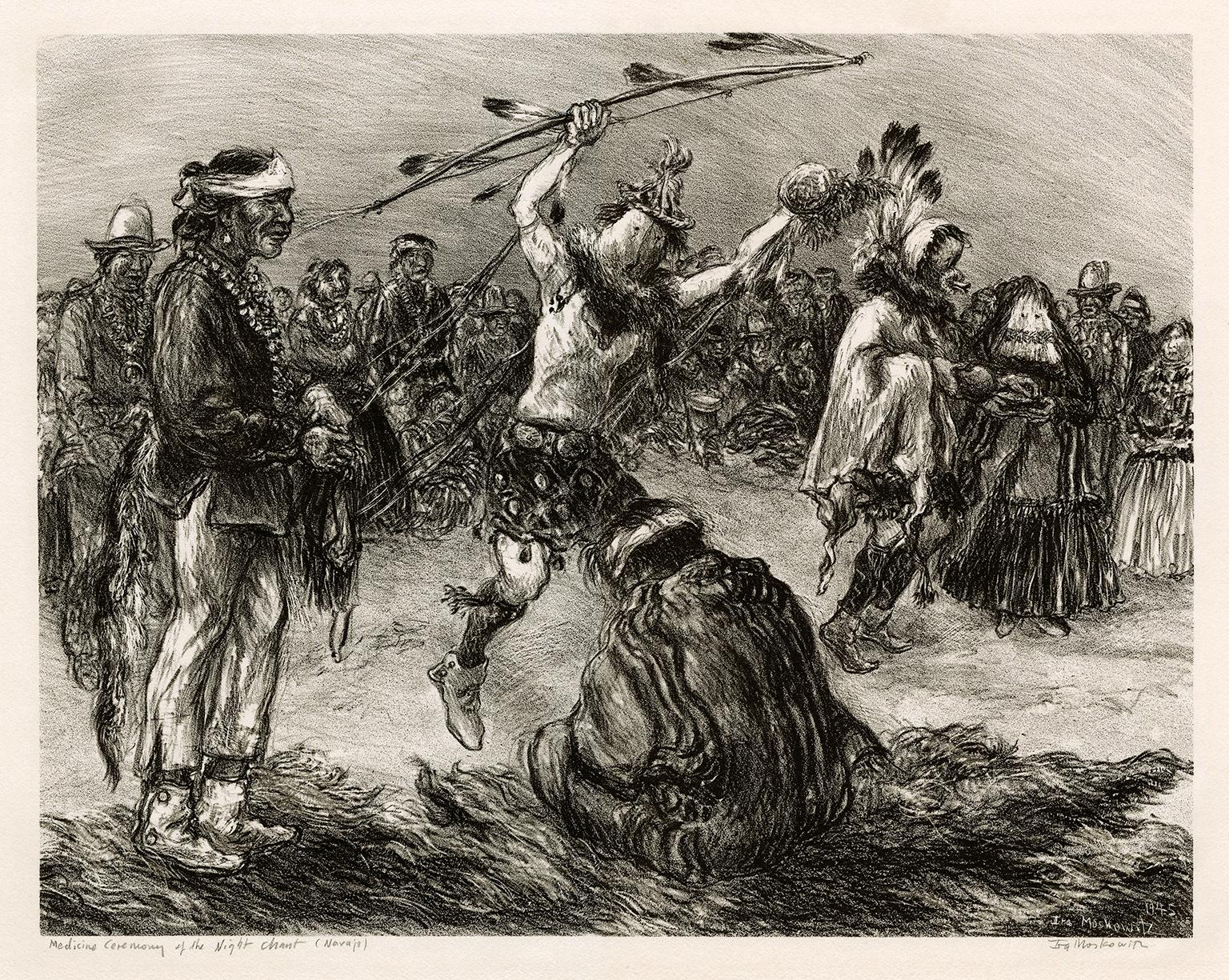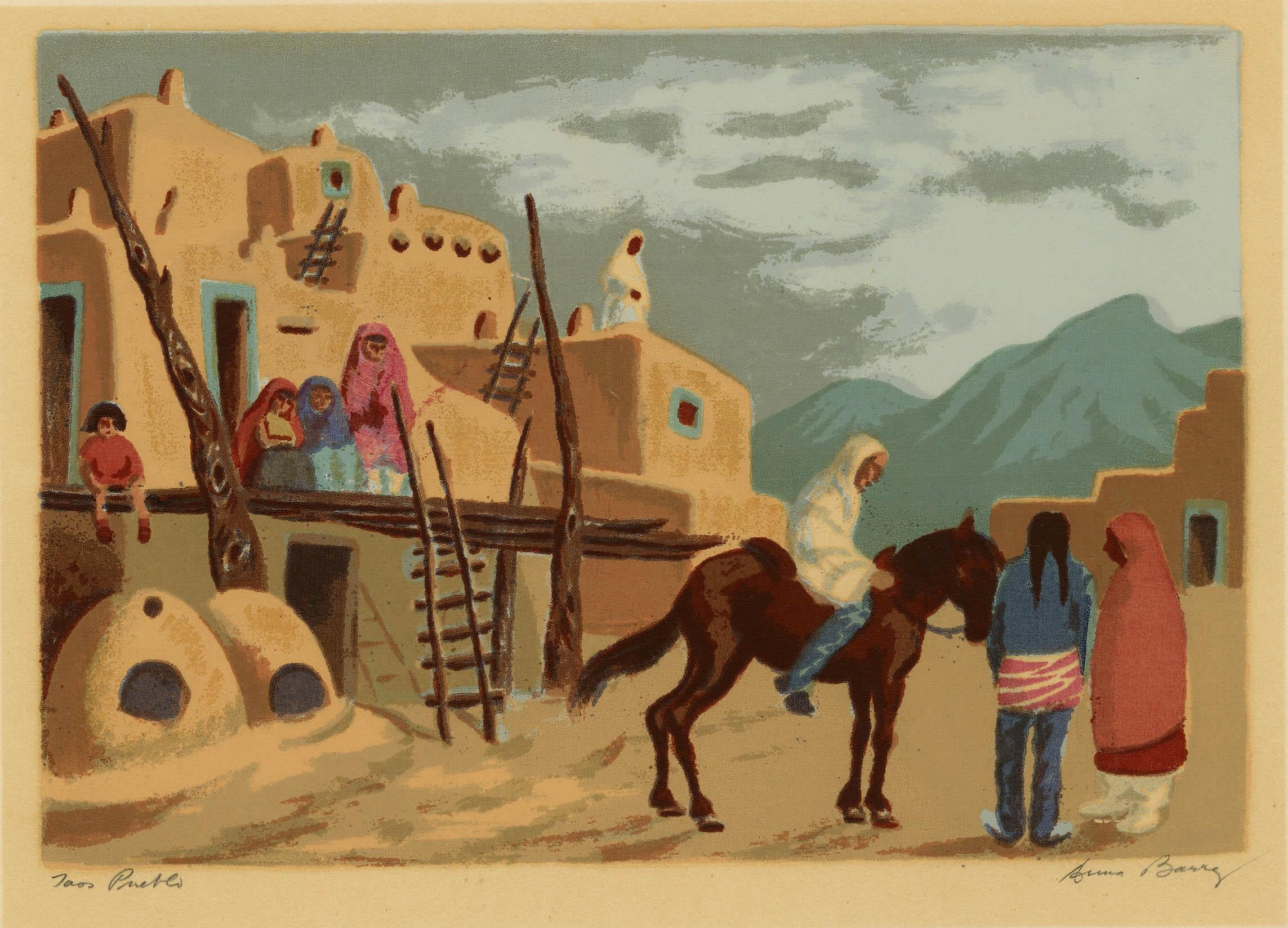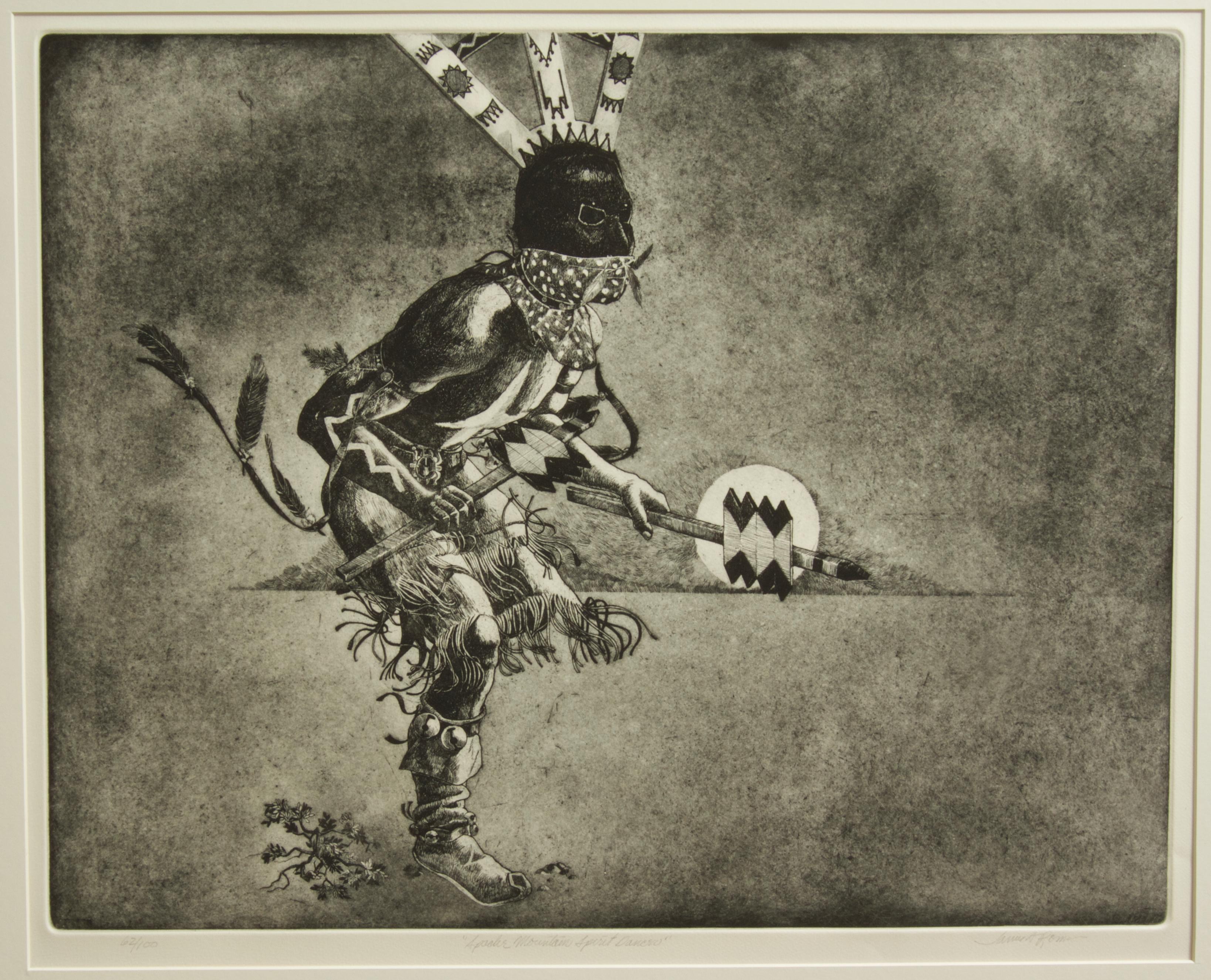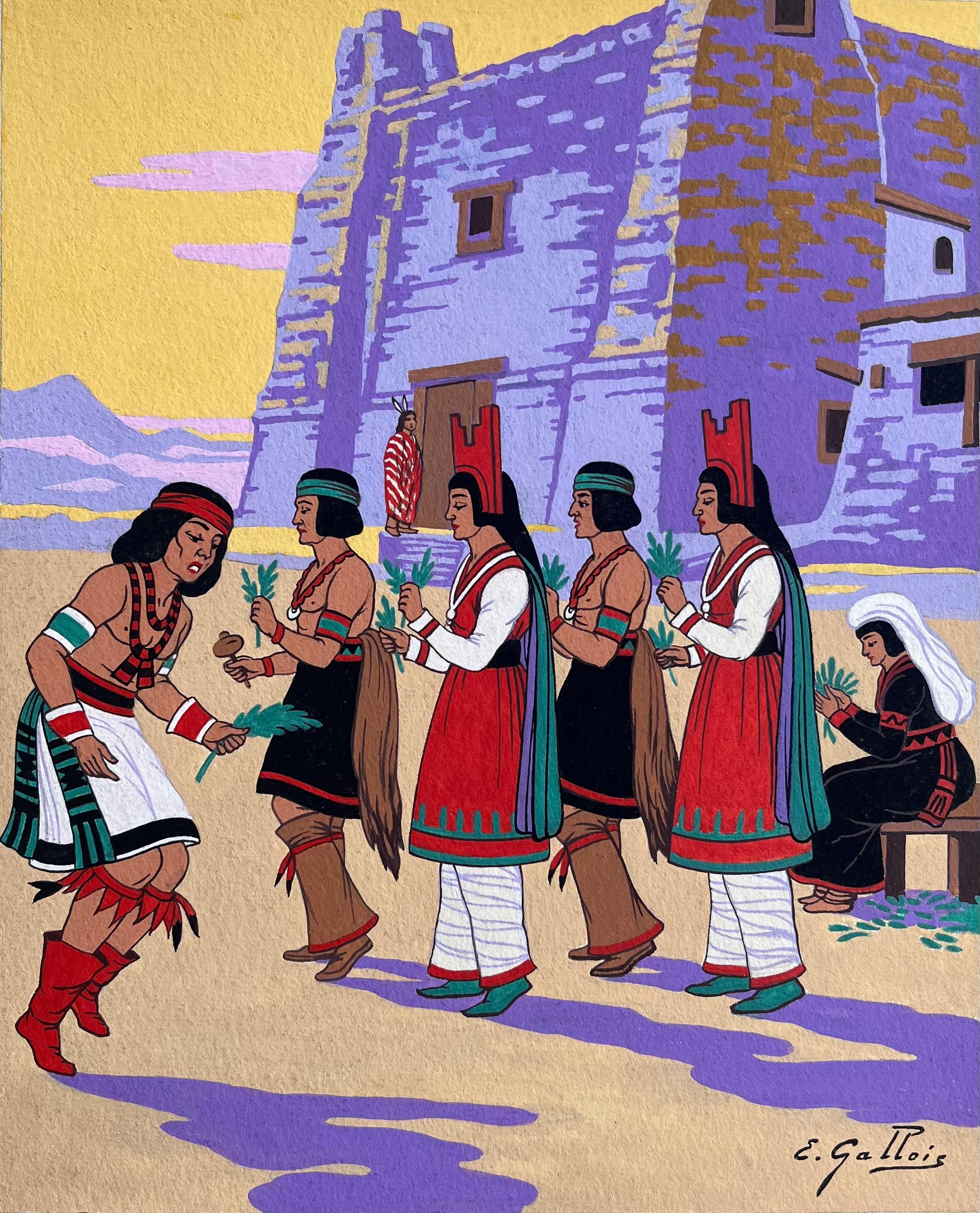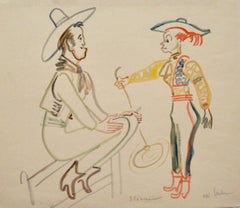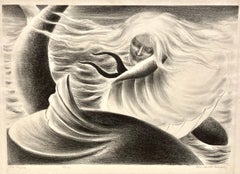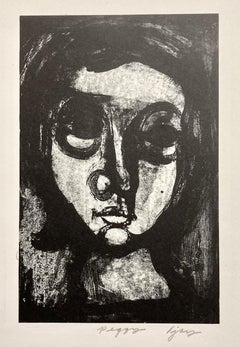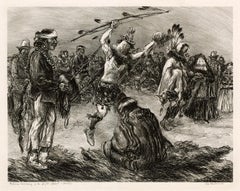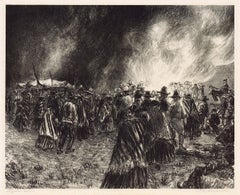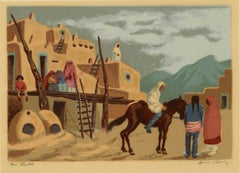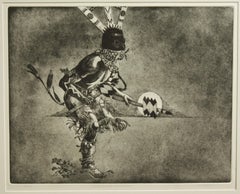Items Similar to Anna Barry, Navajo Yei Bei Chai
Want more images or videos?
Request additional images or videos from the seller
1 of 4
Anna BarryAnna Barry, Navajo Yei Bei Chai1945
1945
$600
£467.14
€531.27
CA$863.08
A$948.25
CHF 495.56
MX$11,308.66
NOK 6,275.14
SEK 5,845.82
DKK 3,969.92
About the Item
Anna Barry (1907-2001), and her husband, the artist Ira Moskovitz, spent years in New Mexico in the late 1930s and 40s. They returned permanently to New York City in 1949.
The screen print (also known as silk screen or serigraph) Navajo Yei Bei Chai records a Native-American healing ceremony. The versatile medium allows for a sensitive interpretation of a complex subject.
The dimensions are for the image of the work. It is signed and titled in pencil.
- Creator:Anna Barry (1907 - 2001)
- Creation Year:1945
- Dimensions:Height: 5 in (12.7 cm)Width: 7 in (17.78 cm)
- Medium:
- Movement & Style:
- Period:
- Condition:
- Gallery Location:New York, NY
- Reference Number:1stDibs: LU141026686892
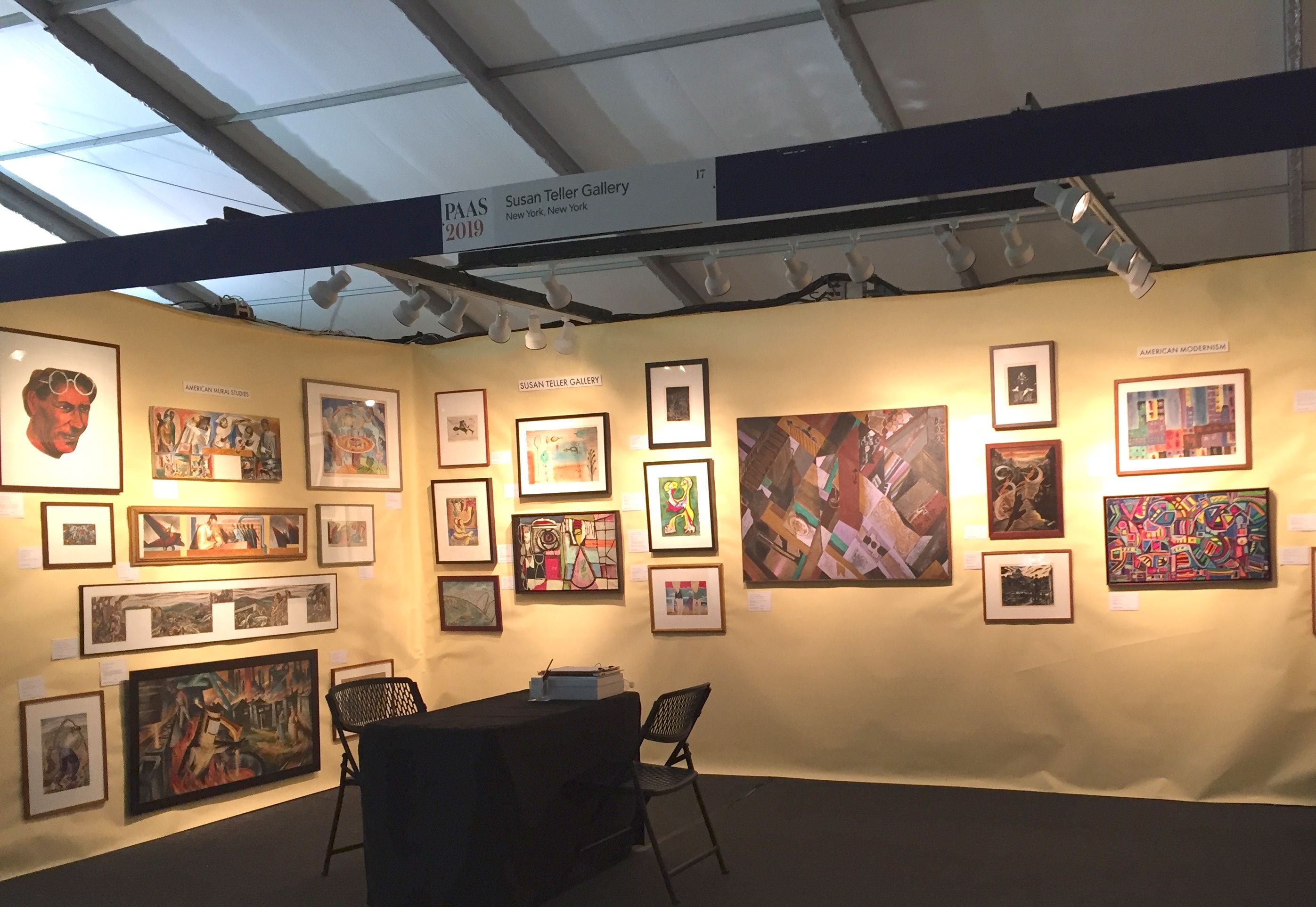
About the Seller
4.9
Gold Seller
Premium sellers maintaining a 4.3+ rating and 24-hour response times
Established in 1988
1stDibs seller since 2020
128 sales on 1stDibs
Typical response time: 7 hours
- ShippingRetrieving quote...Shipping from: New York, NY
- Return Policy
More From This Seller
View AllSanta Fe Cowhands
By Alfred Bendiner
Located in New York, NY
Alfred Bendiner (1899-1964) was trained as an architect but worked as an artist throughout his career. He was a noted lithographer, as well an author, muralist, and caricaturist. The Philadelphia Museum of Art has a major archive of his work.
Bendiner was an incurable traveler. This drawing of Santa Fe...
Category
Mid-20th Century American Modern Figurative Drawings and Watercolors
Materials
Watercolor
Alfred Bendiner, Santa Fe Cowhands (New Mexico)
By Alfred Bendiner
Located in New York, NY
Apparently Bendiner never went a day without drawing. He was amazing!
In this scene of a young 'cowgirl' is working a lasso while an 'old cowhand' looks on -- clutching a cigaret of...
Category
1950s American Modern Figurative Drawings and Watercolors
Materials
Watercolor
Alice Harold Murphy, The Wave
Located in New York, NY
The title, The Wave, lends itself to suggesting that the woman (with her long, flowing hair) is personifying the wave. Or is she one with the wave? Is she push...
Category
Mid-20th Century American Modern Figurative Prints
Materials
Lithograph
Abe Ajay, Peggy
By Abe Ajay
Located in New York, NY
Abraham Ajay (also known as Abe Ajay or even 'Ajay') was from a Syrian Pennsylvanian family who came to New York City. He attended the Art Students League and...
Category
1930s American Modern Figurative Prints
Materials
Lithograph
Frank Kleinholz, World Premier
By Frank Kleinholz
Located in New York, NY
Frank Kleinholz was a lawyer-turned-modernist-artist. This work may have been printed in France in the late 1940s when he went there to learn lithography. He returned to the states i...
Category
Mid-20th Century American Modern Figurative Prints
Materials
Lithograph
Mary Lightfoot, Street Scene in Taos
Located in New York, NY
Mary Lightfoot was born in Ravenna, Texas. She studied at the College of Industrial Arts in Denton and the North Texas State Teachers College prior to receiving a master of arts degree from Columbia University. Her entire teaching career was with the Dallas Public School system; she summered in Europe...
Category
Mid-20th Century American Modern Landscape Prints
Materials
Lithograph
You May Also Like
'Navajo Medicine Ceremony of the Night Chant' — Southwest Regionalism
By Ira Moskowitz
Located in Myrtle Beach, SC
Ira Moskowitz, 'The Three Gods of Healing (Navajo Medicine Ceremony of the Night Chant)', lithograph, 1945, edition 30, Czestochowski 148. Signed and titled in pencil. Signed and dated in the stone, lower right. A fine, richly-inked impression, on cream wove paper, with full margins (2 1/4 to 2 3/4 inches), in excellent condition. Matted to museum standards, unframed.
Image size 12 1/4 x 15 13/16 inches (311 x 402 mm); sheet size 17 1/8 x 20 7/8 inches (435 x 530 mm).
ABOUT THIS WORK
The nine-night ceremony known as the Night Chant or Nightway is believed to date from around 1000 B.C.E. when it was first performed by the Indians who lived in Canyon de Chelly (now eastern Arizona). It is considered the most sacred of all Navajo ceremonies and one of the most difficult and demanding to learn, as it encompasses hundreds of songs, dozens of prayers, and several highly complex sand paintings. And yet the demand for Night Chants is so great that as many as fifty such ceremonies might be held during a single winter season, which lasts eighteen to twenty weeks.
The Night Chant is designed both to cure people who are ill and to restore the order and balance of human and non-human relationships within the Navajo universe. Led by a trained medicine man who has served a long apprenticeship and learned the intricate and detailed practices that are essential to the chant, the ceremony itself is capable of scaring off sickness and ugliness through techniques that shock or arouse. Once the disorder has been removed, order and balance are restored through song, prayer, sand painting, and other aspects of the ceremony.
The medicine men who supervise the Night Chant ensure that everything—each dot and line in every sand painting, each verse in every song, each feather on each mask is arranged precisely, or it will not bring about the desired result. There are probably as many active Night Chant medicine men today as at any time in Navajo history due to the general increase in the Navajo population, the popularity of the ceremony, and the central role it plays in Navajo life and health.
ABOUT THE ARTIST
Ira Moskowitz was born in Galicia, Poland, in 1912, emigrating with his family to New York in 1927. He enrolled at the Art Student's League and studied there from 1928-31. In 1935, Moskowitz traveled to Paris and then lived until 1937 in what is now Israel. He returned to the United States in 1938 to marry artist Anna Barry in New York. The couple soon visited Taos and Santa Fe in New Mexico, returning for extended periods until 1944, when they moved there permanently, staying until 1949. During this especially productive New Mexico period, Moskowitz received a Guggenheim fellowship. His work was inspired by the New Mexico landscape and the state’s three cultures (American Southwest, Native American, and Mexican). He focused on Pueblo and Navajo life, producing an extensive oeuvre of authentic American Indian imagery. He and Anna also visited and sketched across the border in Old Mexico. While in the Southwest, Moskowitz flourished as a printmaker while continuing to produce oils and watercolors. Over 100 of Moskowitz’s works depicting Native American ceremonies were used to illustrate the book American Indian Ceremonial Dances by John Collier, Crown Publishers, New York, 1972.
After leaving the Southwest, printmaking remained an essential medium for the artist while his focus changed to subject matter celebrating Judaic religious life and customs. These works were well received early on, and Moskowitz was content to stay with them the rest of his life. From 1963 until 1966, Moskowitz lived in Paris, returning to New York City in 1967, where he made his permanent home until he died in 2001.
Shortly before his death, Zaplin-Lampert Gallery of Santa Fe staged an exhibition of the artist's works, December 2000 - January 2001. Other one-person shows included the 8th Street Playhouse, New York, 1934; Houston Museum, 1941; and the San Antonio Museum, 1941. The artist’s work was included in exhibitions at the Art Students League, Art Institute of Chicago, Philadelphia Print Club, College Art Association (promotes excellence in scholarship and teaching), and the International Exhibition of Graphic Arts (shown at MOMA, 1955).
Moskowitz’s lithographs of...
Category
1940s American Modern Landscape Prints
Materials
Lithograph
'Navajo Courtship Dance' — Southwest Regionalism, American Indian
By Ira Moskowitz
Located in Myrtle Beach, SC
Ira Moskowitz, 'Navajo Courtship Dance (Squaw Dance)', lithograph, 1946, edition 30, Czestochowski 161. Signed and titled in pencil. Signed and dated in the stone, lower left. A fine, richly-inked impression, on cream wove paper; the full sheet with margins (7/16 to 2 3/4 inches). Pale mat line, otherwise in excellent condition. Matted to museum standards, unframed.
Image size 11 13/16 x 14 13/16 inches (300 x 376 mm); sheet size 13 1/16 x 20 1/8 inches (332 x 511 mm).
ABOUT THE ARTIST
Ira Moskowitz was born in Galicia, Poland, in 1912, emigrating with his family to New York in 1927. He enrolled at the Art Student's League and studied there from 1928-31. In 1935, Moskowitz traveled to Paris and then lived until 1937 in what is now Israel. He returned to the United States in 1938 to marry artist Anna Barry in New York. The couple soon visited Taos and Santa Fe in New Mexico, returning for extended periods until 1944, when they moved there permanently, staying until 1949. During this especially productive New Mexico period, Moskowitz received a Guggenheim fellowship. His work was inspired by the New Mexico landscape and the state’s three cultures (American Southwest, Native American, and Mexican). He focused on Pueblo and Navajo life, producing an extensive oeuvre of authentic American Indian imagery. He and Anna also visited and sketched across the border in Old Mexico. While in the Southwest, Moskowitz flourished as a printmaker while continuing to produce oils and watercolors. Over 100 of Moskowitz’s works depicting Native American ceremonies were used to illustrate the book American Indian Ceremonial Dances by John Collier, Crown Publishers, New York, 1972.
After leaving the Southwest, printmaking remained an essential medium for the artist while his focus changed to subject matter celebrating Judaic religious life and customs. These works were well received early on, and Moskowitz was content to stay with them the rest of his life. From 1963 until 1966, Moskowitz lived in Paris, returning to New York City in 1967, where he made his permanent home until he died in 2001.
Shortly before his death, Zaplin-Lampert Gallery of Santa Fe staged an exhibition of the artist's works, December 2000 - January 2001. Other one-person shows included the 8th Street Playhouse, New York, 1934; Houston Museum, 1941; and the San Antonio Museum, 1941. The artist’s work was included in exhibitions at the Art Students League, Art Institute of Chicago, Philadelphia Print Club, College Art Association (promotes excellence in scholarship and teaching), and the International Exhibition of Graphic Arts (shown at MOMA, 1955).
Moskowitz’s lithographs of...
Category
1940s American Modern Landscape Prints
Materials
Lithograph
Taos Pueblo
By Anna Barry
Located in Fairlawn, OH
Taos Pueblo
Screen print in colors, c. 1945
Signed and titled in pencil by the artist
Printed in Taos
Taos is the oldest continually inhabited city/village in North America.
How old ...
Category
1940s American Modern Landscape Prints
Materials
Screen
Apache Mountain Spirit Dancer
Located in Phoenix, AZ
SHIPPING CHARGES INCLUDE SHIPPING, PACKAGING & **INSURANCE**
Apache Mountain Spirit Dancer
James Rome
Etching 62/100
Image: 21.75 x 27.5 inches
Paper: 25 x...
Category
1980s Contemporary Figurative Prints
Materials
Etching
Navajo Women, state #2
By R.C. Gorman
Located in San Francisco, CA
This artwork "Two Native American Women" 1980 Is an original lithograph on creme Arches paper by renown Navajo artist Rudolph Carl Gorman, 1932-2005. It is signed, dated and numbere...
Category
Late 20th Century Realist Figurative Prints
Materials
Lithograph
French Gouache Painting of Acoma Pueblo Corn Dance in New Mexico
Located in Cirencester, Gloucestershire
Title: French Gouache Painting of Acoma Pueblo Corn Dance in New Mexico
by Emile GALLOIS (1882-1965, French)
Signed: Yes
Medium: Original gouache painting on thick unframed paper,
Si...
Category
Mid-20th Century American Modern Figurative Drawings and Watercolors
Materials
Gouache
More Ways To Browse
Mexican 1930s
Navajo Yei
Salvador Dali The Lovers
Salvador Dali The Ship Of Souls
Salvador Dali Tree Of Knowledge
Sarah Slappey
Shag Josh Agle
Shepard Fairey Guns
Shield Of Achilles
Shigeki Kuroda
Simbari Sylvie
Sol Y Dali
Steffen Thomas
Steinberg Galerie Maeght Poster
Susan Rios Print
Swatch Keith Haring
Tan Tan Bo
Tarkay Serigraphs Signed
